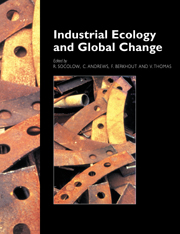Book contents
- Frontmatter
- Contents
- Foreword
- Preface
- Acknowledgments
- Contributors
- OVERVIEW
- PART 1 VULNERABILITY AND ADAPTATION
- PART 2 THE GRAND CYCLES: DISRUPTION AND REPAIR
- PART 3 TOXICS AND THE ENVIRONMENT
- 15 Introduction
- 16 Soil as a Vulnerable Environmental System
- 17 The Vulnerability of Biotic Diversity
- 18 Global Ecotoxicology: Management and Science
- 19 Industrial Activity and Metals Emissions
- 20 Metals Loading of the Environment: Cadmium in the Rhine Basin
- 21 Emissions and Exposure to Metals: Cadmium and Lead
- 22 Nuclear Power: An Industrial Ecology that Failed?
- PART 4 INDUSTRIAL ECOLOGY IN FIRMS
- PART 5 INDUSTRIAL ECOLOGY IN POLICY-MAKING
- END PIECE
- Organizing Committee Members
- Working Groups
- Index
19 - Industrial Activity and Metals Emissions
Published online by Cambridge University Press: 04 August 2010
- Frontmatter
- Contents
- Foreword
- Preface
- Acknowledgments
- Contributors
- OVERVIEW
- PART 1 VULNERABILITY AND ADAPTATION
- PART 2 THE GRAND CYCLES: DISRUPTION AND REPAIR
- PART 3 TOXICS AND THE ENVIRONMENT
- 15 Introduction
- 16 Soil as a Vulnerable Environmental System
- 17 The Vulnerability of Biotic Diversity
- 18 Global Ecotoxicology: Management and Science
- 19 Industrial Activity and Metals Emissions
- 20 Metals Loading of the Environment: Cadmium in the Rhine Basin
- 21 Emissions and Exposure to Metals: Cadmium and Lead
- 22 Nuclear Power: An Industrial Ecology that Failed?
- PART 4 INDUSTRIAL ECOLOGY IN FIRMS
- PART 5 INDUSTRIAL ECOLOGY IN POLICY-MAKING
- END PIECE
- Organizing Committee Members
- Working Groups
- Index
Summary
Abstract
Worldwide industrial emissions of toxic elements to the atmosphere, soils, and water are inventoried. Sources of metal emissions include fossil fuel combustion, mining, metal smelting, industrial processes, and waste incineration. While much of the wastes result in localized or regional contamination problems, the atmospheric emissions of metals have resulted in global contamination. Soils are the largest sink for metal pollution, but aquatic ecosystems are more vulnerable to metals, and may be more affected by the emissions. While there has been a decrease in global atmospheric emissions since 1980, due to pollution control in developed countries, metals pollution in developing countries is believed to be increasing.
Introduction
Metals (and metalloids) and their compounds have been exploited by mankind for many millennia. Brightly colored ochres were put to several uses, including painting, by the cave people. Documented use of galena (lead sulfide, PbS) as magical charms, body paint, or ceremonial powder by pre-colonial inhabitants of North America dates back to the Early Archaic Period (over 8000 years BP; Walthall, 1981). Techniques for the recovery of metals from their ores were discovered around 9000 BP, and by the Roman Empire period, mine production of lead was in excess of 100,000 metric tonnes per year (Nriagu, 1983). It was, however, the dawn of the Industrial Revolution that brought about the unmitigated demand for things metallic. By the present time, over a million metal-containing substances have been synthesized, and at least 10,000 of them are in common use to maintain human health and welfare, drive the industrial economy, and protect national security.
- Type
- Chapter
- Information
- Industrial Ecology and Global Change , pp. 277 - 286Publisher: Cambridge University PressPrint publication year: 1994
- 3
- Cited by



